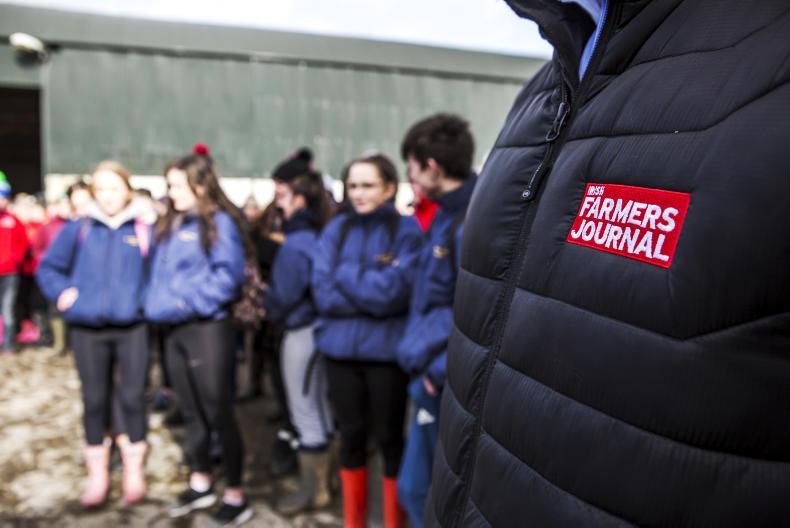Wet weather throughout last autumn and this spring has brought a range of challenges that Dairylink Ireland programme farmers are continuing to deal with. The three case studies from participating farms show that farmers are facing different issues with grassland management as the grazing season finally begins in earnest.
Knowing that there is surplus grass on the platform, or the potential for there to be a deficit if too much is taken out for silage, comes down to knowing how much feed is available in paddocks by grass measuring.
As Nigel Corbett outlines, his average farm cover of 1,040kg DM/ha is deceiving, as supply is quite tight when the highest covers are taken out. By understanding the grass wedge on his farm, he knows to keep cows in by night to lower demand.
On farms where there are lower stocking rates and a more varied range of covers across the milking platform, paddocks with heavier covers can be held for first cut. However, waiting another three weeks until first cut will push stocking rates up for too long on other farms, so heavier covers will need to come out for baled silage now to let paddocks rejoin the grazing rotation.
Away from milking platforms, programme farmers are putting thought into outfarms and paddocks further from the yard, which sometimes receive less attention. Steps are being taken to address soil fertility issues to produce more grass on these blocks this year.
Tight supplies of fodder on many farms this spring have made it clear that every grab of clamp silage and bale of surplus grass is money in the bank.
Trillick, Co Tyrone
This week was the first stable grazing week on the farm this year. The herd is currently split in two, with 60 cows inside full-time and on zero-grazed grass, and 105 cows out at grass day and night.
The main problem throughout the spring has been ground conditions and not grass availability. Average farm cover is 940kg DM/ha and the issue is management of heavy covers that we haven’t been able to get on to until recently.

There are 60 cows inside full-time and on zero-grazed grass on Robin Clements' farm.We are zero-grazing some covers that are over 1,500kg DM/ha on the grazing platform to get them under control, although most of the zero grazing has been on the outfarm. We have been on-off zero-grazing since February.
However, some areas that were cut early on have had compaction problems and will have to be subsoiled.
Fodder stocks are very low and the surplus grass on the farm will mean that we will have a large first-cut silage, which will help replenish silage stocks.
All silage areas have received slurry and 95 units of nitrogen, which was spread over two applications.
There were 70 acres reseeded on the outfarm last year and this has developed into a strong cover. Some of this was zero-grazed earlier on and it will all come out for first-cut around 20 May.
Banbridge, Co Down
All cows got out for a few days of on-off grazing in the first half of April and were out during the day from 15 April. Cows are still housed at night, as grass is tight. Fodder stocks are low and we have been purchasing round bale silage since last week to feed in the evening.
Two paddocks were burned off and ploughed last autumn. However, wet weather prevented any further work. This area has been sprayed again and will be sown out next week. Two other paddocks with high covers have been moved into the silage area. With four paddocks out, the milking platform stocking rate has been pushed to 4.84 CE/ha.
Average farm cover is 1,040kg DM/ha. However, this is pushed up by some very high covers, with one measuring 2,500kgDM/ha. These heavier covers will need to be taken out as baled silage in the next few days to allow the ground back into the grazing round quickly.
All silage area has received 3,000 gallons slurry per acre and 90 units of urea. Grazing areas have received 45 units of nitrogen and some low P and K index paddocks have received a bag of 20:10:10 per acre to improve soil fertility.
Stradone, Co Cavan
Grazing was stop-start for over two months this spring. Cows finally got out by day and night full-time from 20 April. After investing heavily in drainage and reseeding in recent years, I was careful not to damage paddocks. Having an adequate supply of silage meant cows could be housed when ground conditions were tender and so poaching was minimal.
Changeable weather has meant a stop-start beginning to the 2018 grazing season.Some covers over 1,900kg DM/ha in the grazing block have been added into the silage area and other heavier covers have been grazed by cows this week.
On Monday, stocking rate on the platform was 4.0 CE/ha and grass demand was 56kg DM/ha/day. Average growth on the farm last week was only 30kg DM/day/ha, but this was being held back by some heavier covers on wetter ground that were only growing around 10kg DM/ha/day.
I expect grass growth will be around 60kg DM/ha/day this week. This will allow me to take another paddock out for silage, although I will make a final decision on this towards the end of the week.
Milk protein levels have been unstable throughout the spring, with cows moving between grass and silage-based diets. Protein levels moved from 3.0% to 3.5%, which highlights the pressure that was on cows from stop-start grazing.
Wet weather throughout last autumn and this spring has brought a range of challenges that Dairylink Ireland programme farmers are continuing to deal with. The three case studies from participating farms show that farmers are facing different issues with grassland management as the grazing season finally begins in earnest.
Knowing that there is surplus grass on the platform, or the potential for there to be a deficit if too much is taken out for silage, comes down to knowing how much feed is available in paddocks by grass measuring.
As Nigel Corbett outlines, his average farm cover of 1,040kg DM/ha is deceiving, as supply is quite tight when the highest covers are taken out. By understanding the grass wedge on his farm, he knows to keep cows in by night to lower demand.
On farms where there are lower stocking rates and a more varied range of covers across the milking platform, paddocks with heavier covers can be held for first cut. However, waiting another three weeks until first cut will push stocking rates up for too long on other farms, so heavier covers will need to come out for baled silage now to let paddocks rejoin the grazing rotation.
Away from milking platforms, programme farmers are putting thought into outfarms and paddocks further from the yard, which sometimes receive less attention. Steps are being taken to address soil fertility issues to produce more grass on these blocks this year.
Tight supplies of fodder on many farms this spring have made it clear that every grab of clamp silage and bale of surplus grass is money in the bank.
Trillick, Co Tyrone
This week was the first stable grazing week on the farm this year. The herd is currently split in two, with 60 cows inside full-time and on zero-grazed grass, and 105 cows out at grass day and night.
The main problem throughout the spring has been ground conditions and not grass availability. Average farm cover is 940kg DM/ha and the issue is management of heavy covers that we haven’t been able to get on to until recently.

There are 60 cows inside full-time and on zero-grazed grass on Robin Clements' farm.We are zero-grazing some covers that are over 1,500kg DM/ha on the grazing platform to get them under control, although most of the zero grazing has been on the outfarm. We have been on-off zero-grazing since February.
However, some areas that were cut early on have had compaction problems and will have to be subsoiled.
Fodder stocks are very low and the surplus grass on the farm will mean that we will have a large first-cut silage, which will help replenish silage stocks.
All silage areas have received slurry and 95 units of nitrogen, which was spread over two applications.
There were 70 acres reseeded on the outfarm last year and this has developed into a strong cover. Some of this was zero-grazed earlier on and it will all come out for first-cut around 20 May.
Banbridge, Co Down
All cows got out for a few days of on-off grazing in the first half of April and were out during the day from 15 April. Cows are still housed at night, as grass is tight. Fodder stocks are low and we have been purchasing round bale silage since last week to feed in the evening.
Two paddocks were burned off and ploughed last autumn. However, wet weather prevented any further work. This area has been sprayed again and will be sown out next week. Two other paddocks with high covers have been moved into the silage area. With four paddocks out, the milking platform stocking rate has been pushed to 4.84 CE/ha.
Average farm cover is 1,040kg DM/ha. However, this is pushed up by some very high covers, with one measuring 2,500kgDM/ha. These heavier covers will need to be taken out as baled silage in the next few days to allow the ground back into the grazing round quickly.
All silage area has received 3,000 gallons slurry per acre and 90 units of urea. Grazing areas have received 45 units of nitrogen and some low P and K index paddocks have received a bag of 20:10:10 per acre to improve soil fertility.
Stradone, Co Cavan
Grazing was stop-start for over two months this spring. Cows finally got out by day and night full-time from 20 April. After investing heavily in drainage and reseeding in recent years, I was careful not to damage paddocks. Having an adequate supply of silage meant cows could be housed when ground conditions were tender and so poaching was minimal.
Changeable weather has meant a stop-start beginning to the 2018 grazing season.Some covers over 1,900kg DM/ha in the grazing block have been added into the silage area and other heavier covers have been grazed by cows this week.
On Monday, stocking rate on the platform was 4.0 CE/ha and grass demand was 56kg DM/ha/day. Average growth on the farm last week was only 30kg DM/day/ha, but this was being held back by some heavier covers on wetter ground that were only growing around 10kg DM/ha/day.
I expect grass growth will be around 60kg DM/ha/day this week. This will allow me to take another paddock out for silage, although I will make a final decision on this towards the end of the week.
Milk protein levels have been unstable throughout the spring, with cows moving between grass and silage-based diets. Protein levels moved from 3.0% to 3.5%, which highlights the pressure that was on cows from stop-start grazing.














SHARING OPTIONS